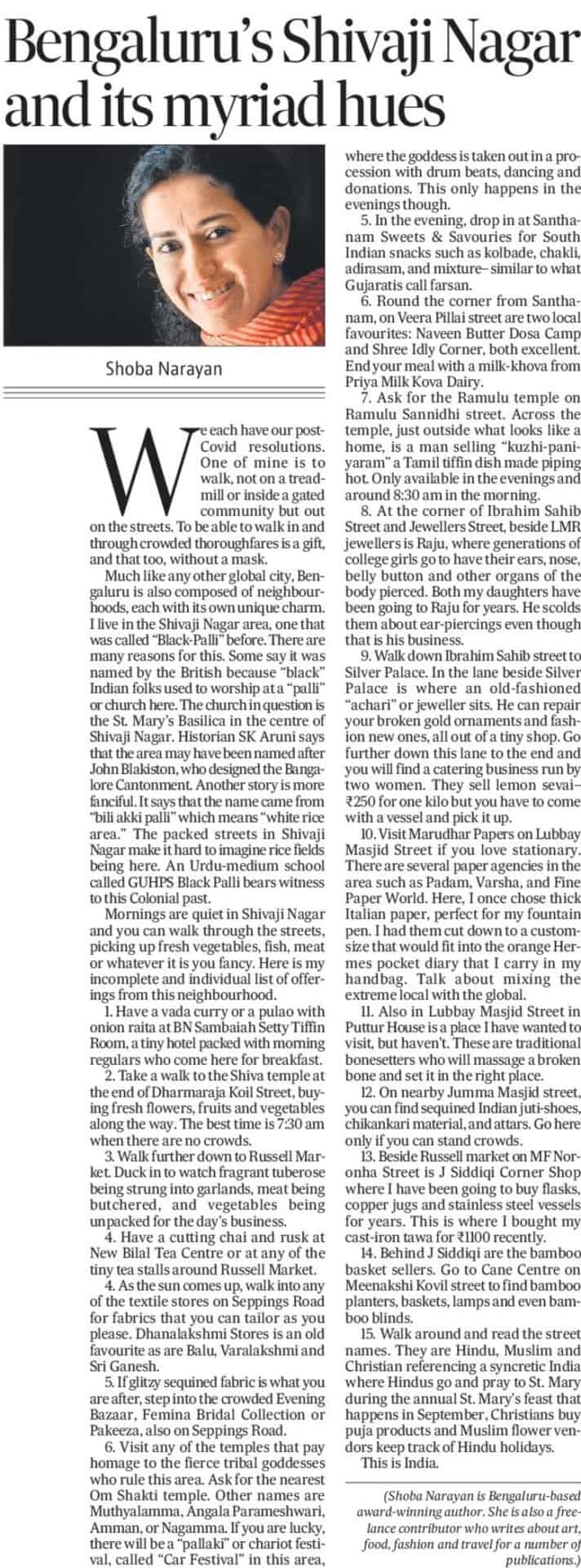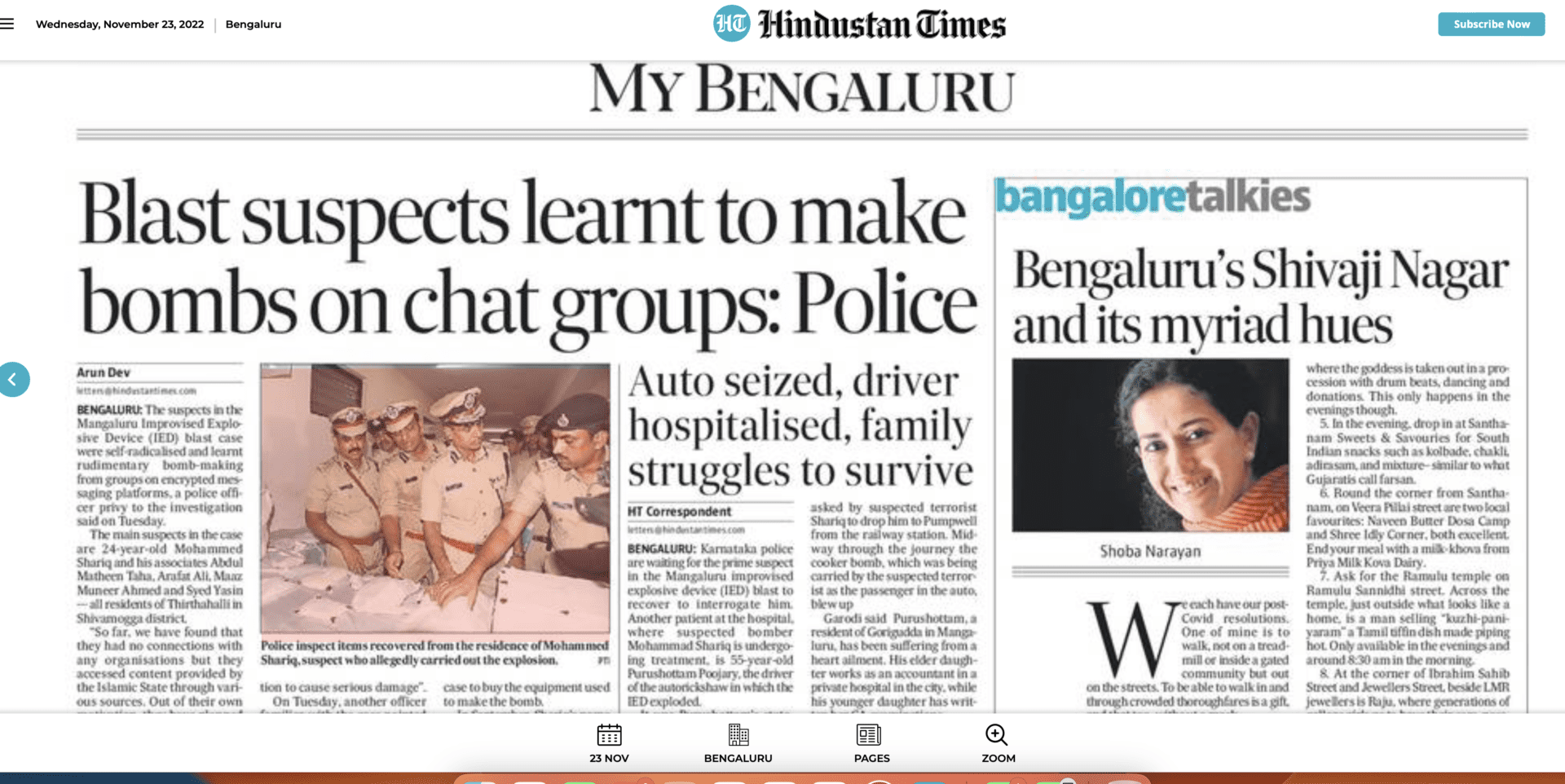We each have our post-Covid resolutions. One of mine is to walk, not on a treadmill or inside a gated community but out on the streets. To be able to walk in and through crowded thoroughfares is a gift, and that too, without a mask.
Much like any other global city, Bengaluru is also composed of neighbourhoods, each with its own unique charm. I live in the Shivaji Nagar area, one that was called “Black-Palli” before. There are many reasons for this. Some say it was named by the British because “black” Indian folks used to worship at a “palli” or church here. The church in question is the St. Mary’s Basilica in the centre of Shivaji Nagar. Historian SK Aruni says that the area may have been named after John Blakiston, who designed the Bangalore Cantonment. Another story is more fanciful. It says that the name came from “bili akki palli” which means “white rice area.” The packed streets in Shivaji Nagar make it hard to imagine rice fields being here. An Urdu-medium school called GUHPS Black Palli bears witness to this Colonial past.
Mornings are quiet in Shivaji Nagar and you can walk through the streets, picking up fresh vegetables, fish, meat or whatever it is you fancy. Here is my incomplete and individual list of offerings from this neighbourhood.

- Have a vada curry or a pulao with onion raita at BN Sambaiah Setty Tiffin Room, a tiny hotel packed with morning regulars who come here for breakfast.
- Take a walk to the Shiva temple at the end of Dharmaraja Koil Street, buying fresh flowers, fruits and vegetables along the way. The best time is 7:30 am when there are no crowds.
- Walk further down to Russell Market. Duck in to watch fragrant tuberose being strung into garlands, meat being butchered, and vegetables being unpacked for the day’s business.
- Have a cutting chai and rusk at New Bilal Tea Centre or at any of the tiny tea stalls around Russell Market.
- As the sun comes up, walk into any of the textile stores on Seppings Road for fabrics that you can tailor as you please. Dhanalakshmi Stores is an old favourite as are Balu, Varalakshmi and Sri Ganesh.
- If glitzy sequined fabric is what you are after, step into the crowded Evening Bazaar, Femina Bridal Collection or Pakeeza, also on Seppings Road.
- Visit any of the temples that pay homage to the fierce tribal goddesses who rule this area. Ask for the nearest Om Shakti temple. Other names are Muthyalamma, Angala Parameshwari, Amman, or Nagamma. If you are lucky, there will be a “pallaki” or chariot festival, called “Car Festival” in this area, where the goddess is taken out in a procession with drum beats, dancing and donations. This only happens in the evenings though.
- In the evening, drop in at Santhanam Sweets & Savouries for South Indian snacks such as kolbade, chakli, adirasam, and mixture– similar to what Gujaratis call farsan.
- Round the corner from Santhanam, on Veera Pillai street are two local favourites: Naveen Butter Dosa Camp and Shree Idly Corner, both excellent. End your meal with a milk-khova from Priya Milk Kova Dairy.
- Ask for the Ramulu temple on Ramulu Sannidhi street. Across the temple, just outside what looks like a home, is a man selling “kuzhi-paniyaram” a Tamil tiffin dish made piping hot. Only available in the evenings and around 8:30 am in the morning.
- At the corner of Ibrahim Sahib Street and Jewellers Street, beside LMR jewellers is Raju, where generations of college girls go to have their ears, nose, belly button and other organs of the body pierced. Both my daughters have been going to Raju for years. He scolds them about ear-piercings even though that is his business.
- Walk down Ibrahim Sahib street to Silver Palace. In the lane beside Silver Palace is where an old-fashioned “achari” or jeweller sits. He can repair your broken gold ornaments and fashion new ones, all out of a tiny shop. Go further down this lane to the end and you will find a catering business run by two women. They sell lemon sevai– ₹250 for one kilo but you have to come with a vessel and pick it up.
- Visit Marudhar Papers on Lubbay Masjid Street if you love stationary. There are several paper agencies in the area such as Padam, Varsha, and Fine Paper World. Here, I once chose thick Italian paper, perfect for my fountain pen. I had them cut down to a custom-size that would fit into the orange Hermes pocket diary that I carry in my handbag. Talk about mixing the extreme local with the global.
14. Also in Lubbay Masjid Street in Puttur House is a place I have wanted to visit, but haven’t. These are traditional bonesetters who will massage a broken bone and set it in the right place. On nearby Jumma Masjid street, you can find sequined Indian juti-shoes, chikankari material, and attars. Go here only if you can stand crowds. Beside Russell market on MF Noronha Street is J Siddiqi Corner Shop where I have been going to buy flasks, copper jugs and stainless steel vessels for years. This is where I bought my cast-iron tawa for ₹1100 recently. Behind J Siddiqi are the bamboo basket sellers. Go to Cane Centre on Meenakshi Kovil street to find bamboo planters, baskets, lamps and even bamboo blinds.
15. Walk around and read the street names. They are Hindu, Muslim and Christian referencing a syncretic India where Hindus go and pray to St. Mary during the annual St. Mary’s feast that happens in September, Christians buy puja products and Muslim flower vendors keep track of Hindu holidays.





Leave A Comment